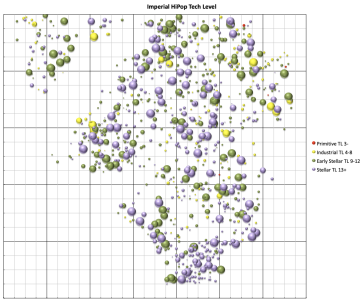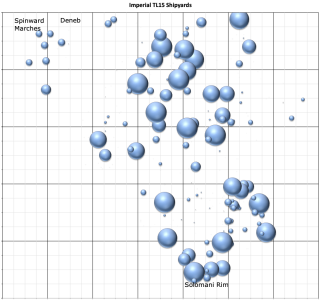Spirit of 1977
Cosmic Mongoose
Two things about this one: 1) There's math. Sorry. 2) While the rules clearly produce these results, they are never mentioned otherwise. So the implications are much more speculative, up to and including "I would never run my setting this way." With that out of the way...
From Traveller's beginning and to this day, the base population of a main world is determined by 2D-2 being an exponent of 10 to compute total population. Later rules clarified that you could multiple this by 1-9, so Pop 0 is 1-9 sophonts, and Pop A (10) is 10 to 90 billion, for example.
For a 2D-2 roll, both the median (exact center, 50th percentile) and mode (single most frequent outcome) is 5: hundreds of thousands. But the MEAN (average) population (using the actual population and not the Pop number) is 9: billions! This means that the large population planets contain nearly all of the population.
Here's a table:
It's the 80/20 rule on steroids! A Star Empire could ignore over 97% of all planets and still attend to over 80% of the population. A cutoff of Pop 8 or 9 seems very reasonable decision to make. Now again, the rules don't discuss this at all, so why discuss it? Like the mechanics of jump and the rarity of travel, it imparts a feel just from the rules existing. In this case, it reinforces the "planets and characters are on their own" spirit of the game.
Some implications for adventures:
1) "Planet of Hats" might be the norm: "Planet of Hats" is a trope associated with arguably lazy storytelling, where all the sophonts of a world have some single defining feature, particularly if that world is never visited again. Sophonts can start off "hatty" and become well-rounded from sheer long-time development (think any major alien from Star Trek). But in a setting where most planets are simply unimportant to the Empire, and travel is rare, what might cause travel to happen? Sophonts who are desperate or fed up. And if you have a huge number of worlds to choose from, and you don't just want to be alone, why would you not seek out the like-minded? I suspect that the many low Pop worlds in Traveller would contain beings more similar than different, else why would they stay?
I saw a comment somewhere that Traveller high Pop/Gov/Law worlds look like hellscape dystopias, with all the authoritarian regimes and oppressive laws. But one thing a Traveller Star Empire would seem to want to encourage is travel and trade. We won't interfere with your world, but you can't impede movement. Under this assumption, most of the citizens of that Religious Dictatorship are totally cool with it! True believers, all. There might a few dissidents, but only a few.
2) Planet of Jasper, Missouris: For those of you who get the reference, sorry! If not, Jasper, Missouri was the setting for Road House, an over the top action flick starring the late Patrick Swayze playing a zen ("pain don't hurt") martial artist philosopher bouncer (sorry, "Cooler"). But the setting is a town essentially owned by a rural gangster who terrorizes the population while partying non-stop. In other words, a fabulous Traveller setting that would only work well on a small unimportant planet. Firefly did something like this as well, with "Heart of Gold". In fact, the entire Firefly 'Verse lives this idea of a few important worlds and the rest unimportant.
3) Fantastic Tech Xenophobes: Old Star Trek was loaded with these: Metrons, Organians, Melkorians, the Q. Super advanced aliens who did not seem to travel much and even tried to stay hidden. Perfect for Traveller encounters, and yet only making sense if the world can be overlooked by seeming unimportant. I always wondered why Traveller didn't publish more adventures like this. I think the answer is that, by fleshing out the Third Imperium so thoroughly, it gave the impression of being very settled. That might have been a mistake, and I think this math justifies keeping a large Star Empire less explored. a World being "in" an Empire is not the same as being "of" the Empire.
If this math has never occurred to you, does seeing it give you any new ideas? Should Traveller make this math more explicit, or having seen this, change the way Pop is computed so that it is better spread out?
From Traveller's beginning and to this day, the base population of a main world is determined by 2D-2 being an exponent of 10 to compute total population. Later rules clarified that you could multiple this by 1-9, so Pop 0 is 1-9 sophonts, and Pop A (10) is 10 to 90 billion, for example.
For a 2D-2 roll, both the median (exact center, 50th percentile) and mode (single most frequent outcome) is 5: hundreds of thousands. But the MEAN (average) population (using the actual population and not the Pop number) is 9: billions! This means that the large population planets contain nearly all of the population.
Here's a table:
| If Pop is at least | % of planets | % of population |
| 7 | 27.8% | 99.95% |
| 8 | 16.7% | 99.6% |
| 9 | 8.3% | 97.2% |
| 10 | 2.8% | 81.0% |
It's the 80/20 rule on steroids! A Star Empire could ignore over 97% of all planets and still attend to over 80% of the population. A cutoff of Pop 8 or 9 seems very reasonable decision to make. Now again, the rules don't discuss this at all, so why discuss it? Like the mechanics of jump and the rarity of travel, it imparts a feel just from the rules existing. In this case, it reinforces the "planets and characters are on their own" spirit of the game.
Some implications for adventures:
1) "Planet of Hats" might be the norm: "Planet of Hats" is a trope associated with arguably lazy storytelling, where all the sophonts of a world have some single defining feature, particularly if that world is never visited again. Sophonts can start off "hatty" and become well-rounded from sheer long-time development (think any major alien from Star Trek). But in a setting where most planets are simply unimportant to the Empire, and travel is rare, what might cause travel to happen? Sophonts who are desperate or fed up. And if you have a huge number of worlds to choose from, and you don't just want to be alone, why would you not seek out the like-minded? I suspect that the many low Pop worlds in Traveller would contain beings more similar than different, else why would they stay?
I saw a comment somewhere that Traveller high Pop/Gov/Law worlds look like hellscape dystopias, with all the authoritarian regimes and oppressive laws. But one thing a Traveller Star Empire would seem to want to encourage is travel and trade. We won't interfere with your world, but you can't impede movement. Under this assumption, most of the citizens of that Religious Dictatorship are totally cool with it! True believers, all. There might a few dissidents, but only a few.
2) Planet of Jasper, Missouris: For those of you who get the reference, sorry! If not, Jasper, Missouri was the setting for Road House, an over the top action flick starring the late Patrick Swayze playing a zen ("pain don't hurt") martial artist philosopher bouncer (sorry, "Cooler"). But the setting is a town essentially owned by a rural gangster who terrorizes the population while partying non-stop. In other words, a fabulous Traveller setting that would only work well on a small unimportant planet. Firefly did something like this as well, with "Heart of Gold". In fact, the entire Firefly 'Verse lives this idea of a few important worlds and the rest unimportant.
3) Fantastic Tech Xenophobes: Old Star Trek was loaded with these: Metrons, Organians, Melkorians, the Q. Super advanced aliens who did not seem to travel much and even tried to stay hidden. Perfect for Traveller encounters, and yet only making sense if the world can be overlooked by seeming unimportant. I always wondered why Traveller didn't publish more adventures like this. I think the answer is that, by fleshing out the Third Imperium so thoroughly, it gave the impression of being very settled. That might have been a mistake, and I think this math justifies keeping a large Star Empire less explored. a World being "in" an Empire is not the same as being "of" the Empire.
If this math has never occurred to you, does seeing it give you any new ideas? Should Traveller make this math more explicit, or having seen this, change the way Pop is computed so that it is better spread out?

